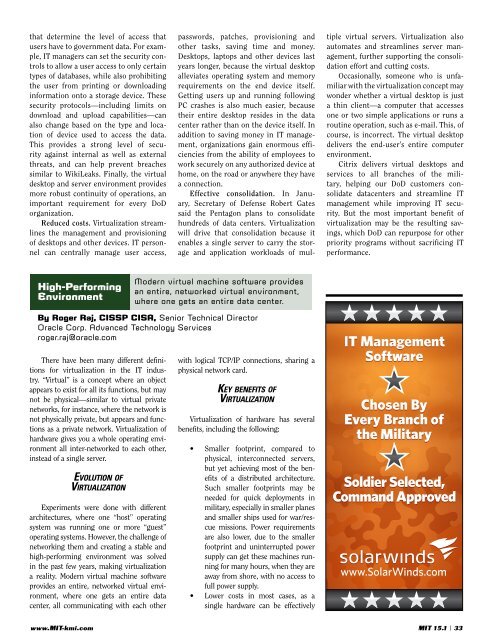C4 Marine Brig. Gen. Kevin J. Nally - KMI Media Group
C4 Marine Brig. Gen. Kevin J. Nally - KMI Media Group
C4 Marine Brig. Gen. Kevin J. Nally - KMI Media Group
Create successful ePaper yourself
Turn your PDF publications into a flip-book with our unique Google optimized e-Paper software.
that determine the level of access that<br />
users have to government data. For example,<br />
IT managers can set the security controls<br />
to allow a user access to only certain<br />
types of databases, while also prohibiting<br />
the user from printing or downloading<br />
information onto a storage device. These<br />
security protocols—including limits on<br />
download and upload capabilities—can<br />
also change based on the type and location<br />
of device used to access the data.<br />
This provides a strong level of security<br />
against internal as well as external<br />
threats, and can help prevent breaches<br />
similar to WikiLeaks. Finally, the virtual<br />
desktop and server environment provides<br />
more robust continuity of operations, an<br />
important requirement for every DoD<br />
organization.<br />
Reduced costs. Virtualization streamlines<br />
the management and provisioning<br />
of desktops and other devices. IT personnel<br />
can centrally manage user access,<br />
High-Performing<br />
Environment<br />
There have been many different definitions<br />
for virtualization in the IT industry.<br />
“Virtual” is a concept where an object<br />
appears to exist for all its functions, but may<br />
not be physical—similar to virtual private<br />
networks, for instance, where the network is<br />
not physically private, but appears and functions<br />
as a private network. Virtualization of<br />
hardware gives you a whole operating environment<br />
all inter-networked to each other,<br />
instead of a single server.<br />
evolutIon of<br />
vIrtualIzatIon<br />
Experiments were done with different<br />
architectures, where one “host” operating<br />
system was running one or more “guest”<br />
operating systems. However, the challenge of<br />
networking them and creating a stable and<br />
high-performing environment was solved<br />
in the past few years, making virtualization<br />
a reality. Modern virtual machine software<br />
provides an entire, networked virtual environment,<br />
where one gets an entire data<br />
center, all communicating with each other<br />
passwords, patches, provisioning and<br />
other tasks, saving time and money.<br />
Desktops, laptops and other devices last<br />
years longer, because the virtual desktop<br />
alleviates operating system and memory<br />
requirements on the end device itself.<br />
Getting users up and running following<br />
PC crashes is also much easier, because<br />
their entire desktop resides in the data<br />
center rather than on the device itself. In<br />
addition to saving money in IT management,<br />
organizations gain enormous efficiencies<br />
from the ability of employees to<br />
work securely on any authorized device at<br />
home, on the road or anywhere they have<br />
a connection.<br />
Effective consolidation. In January,<br />
Secretary of Defense Robert Gates<br />
said the Pentagon plans to consolidate<br />
hundreds of data centers. Virtualization<br />
will drive that consolidation because it<br />
enables a single server to carry the storage<br />
and application workloads of mul-<br />
Modern virtual machine software provides<br />
an entire, networked virtual environment,<br />
where one gets an entire data center.<br />
By Roger Raj, CISSP CISA, Senior Technical Director<br />
Oracle Corp. Advanced Technology Services<br />
roger.raj@oracle.com<br />
with logical TCP/IP connections, sharing a<br />
physical network card.<br />
key BenefIts of<br />
vIrtualIzatIon<br />
Virtualization of hardware has several<br />
benefits, including the following:<br />
• Smaller footprint, compared to<br />
physical, interconnected servers,<br />
but yet achieving most of the benefits<br />
of a distributed architecture.<br />
Such smaller footprints may be<br />
needed for quick deployments in<br />
military, especially in smaller planes<br />
and smaller ships used for war/rescue<br />
missions. Power requirements<br />
are also lower, due to the smaller<br />
footprint and uninterrupted power<br />
supply can get these machines running<br />
for many hours, when they are<br />
away from shore, with no access to<br />
full power supply.<br />
• Lower costs in most cases, as a<br />
single hardware can be effectively<br />
tiple virtual servers. Virtualization also<br />
automates and streamlines server management,<br />
further supporting the consolidation<br />
effort and cutting costs.<br />
Occasionally, someone who is unfamiliar<br />
with the virtualization concept may<br />
wonder whether a virtual desktop is just<br />
a thin client—a computer that accesses<br />
one or two simple applications or runs a<br />
routine operation, such as e-mail. This, of<br />
course, is incorrect. The virtual desktop<br />
delivers the end-user’s entire computer<br />
environment.<br />
Citrix delivers virtual desktops and<br />
services to all branches of the military,<br />
helping our DoD customers consolidate<br />
datacenters and streamline IT<br />
management while improving IT security.<br />
But the most important benefit of<br />
virtualization may be the resulting savings,<br />
which DoD can repurpose for other<br />
priority programs without sacrificing IT<br />
performance.<br />
www.MIT-kmi.com MIT 15.1 | 33
















